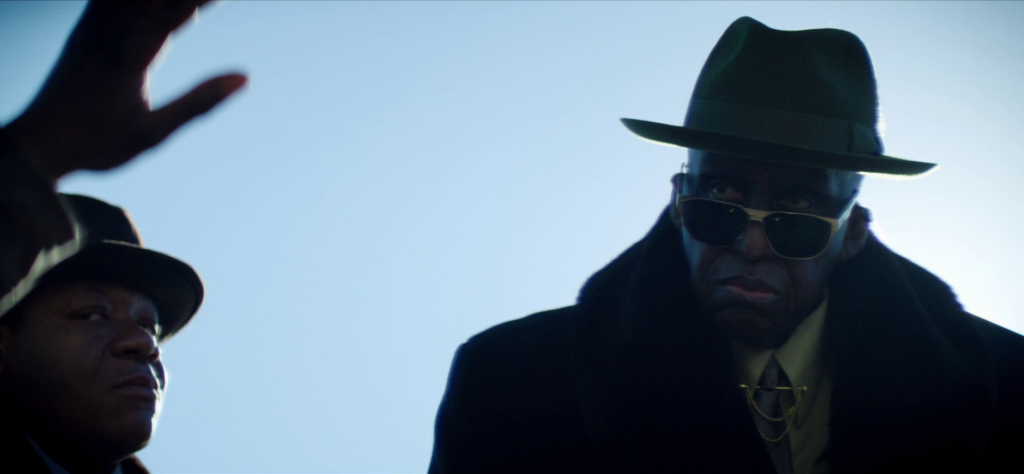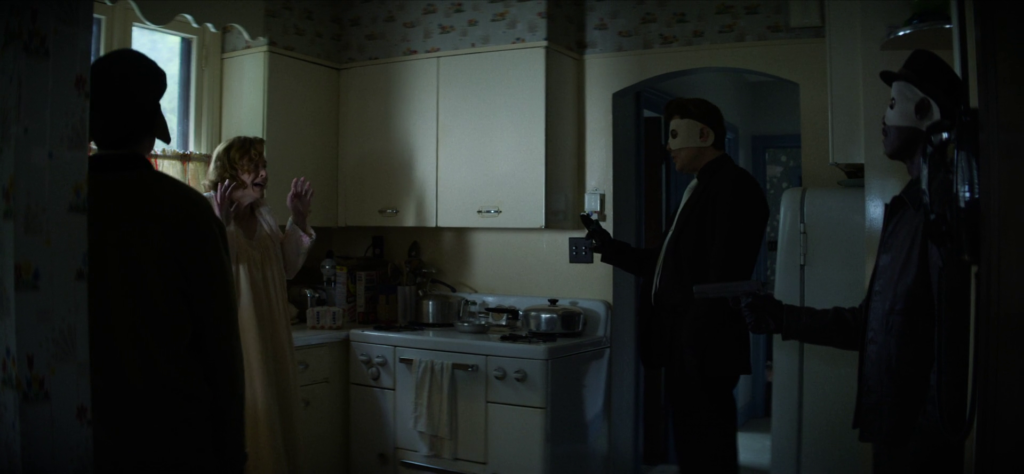
Film Review: No Sudden Move
Directed by Steven Soderbergh. US, 2021, 115 minutes.
Available with subscription on HBO Max.
There’s a handful of artists you could nominate to be the current godfather of American crime movies, but one nominee that’s probably not mentioned enough is Bill Duke. Across his 40-plus-year career of both acting in and directing films, Duke has constantly returned to crime fiction—sometimes adapting the classics, and sometimes contributing to new ones. First he earned directorial cred doing episodes of seminal cop shows like Hill Street Blues (1981-87) and Miami Vice (1984-90), later he performed in low-scale adaptations of novels by mystery Grand Masters like Elmore Leonard (Freaky Deaky, 2012) and Walter Mosley (Always Outnumbered, 1998), and in between he directed his own adaptations of mainstay characters like Chester Himes’ Harlem Detectives (A Rage in Harlem, 1991) and Rex Stout’s Nero Wolfe (The Golden Spiders, 2000). To seal his application, Duke also directed a genuine classic American crime movie from original material with Deep Cover (1992), a furiously stylized war on drugs detective story that conjures up an impenetrable smog of historical, sociopolitical, and even biblical implications (the film is scheduled for a home-video re-release by the Criterion Collection on July 13, an institutional rubber stamp confirming its slow-growing reputation as one of the best Hollywood films of the 1990s).
That’s all to say that while it wouldn’t be the first choice, or even the second or third or fourth, a hypothetical book covering American crime fiction stories of page and screen from the 19th century until the present day could pretty credibly be subtitled From Dupin to Bill Duke. And that’s worth mentioning now because Duke literally plays a criminal godfather in No Sudden Move, a substantive new film that’s very self conscious about its own place in the history of “American crime fiction stories.”
No Sudden Move’s direction, editing, and cinematography is by Steven Soderbergh, who’s been making pulp-informed crime films on and off since The Underneath (1995), including a vitalizing (and self-defining) adaptation of Leonard’s Out of Sight (1998). The film’s two lead actors are Don Cheadle, who broke through playing Mouse in director Carl Franklin’s 1995 film adaptation of Mosley’s first Easy Rawlins detective novel Devil in a Blue Dress (1990); and Benecio Del Toro, whose own breakthrough roles also came in crime films (albeit mediocre ones like The Usual Suspects, 1995, The Way of the Gun, 2000, and Snatch, 2000). Additionally, No Sudden Move’s supporting cast includes Ray Liotta, who’s seen as the living personification of Goodfellas (1990) but also features in countless other worthy crime movies including the last George V. Higgins adaptation Killing Them Softly (2013); and Julia Fox, who played a very crucial role in the most recent “genuine classic American crime movie” Uncut Gems (2019).
Actually even the No Sudden Move cast members without much of a crime fiction pedigree, like Brendan Fraser and Jon Hamm, look as if they walked off the set of some old Hollywood potboiler like Plunder Road (1957) or something.

These additional citations are worth mentioning here too because No Sudden Move, which is set in Detroit during 1954 under the shadow of the postwar sales battles between car manufacturers, is basically scripted by citation—to a degree where one can reverse-engineer the movie from other crime stories just by describing the plot.
The lead character is Curt Goynes (Cheadle), a Black man in a segregated city who’s called upon by white men for mysterious extralegal work and who agrees to do so despite his decent moral compass simply because he’d like to invest the racially-fraught payoff into a real estate investment (which is all quite similar to the Easy Rawlins character depicted in the first couple Mosley books, right down to the real estate). Goynes is assigned to a heist job where the plan is to invade a man’s home and “babysit” his family until the guy steals for them (which is direct from Higgins’ The Friends of Eddie Coyle, 1970), but things go wrong and Goynes finds out the job’s target was not straight cash but valuable secret documents related to the automotive business instead (which is likely borrowed from Paul Schrader’s very great movie Blue Collar, 1979). Working to get ahead of the oncoming kill-offs, Goynes crosses racial lines to search for the heisted objects alongside small-time Italian gangster Ronald Russo (Del Toro), and inadvertently sets into motion a cycle of Leonard-esque double-crosses (a connection implicitly confirmed by the Detroit setting—Dutch’s hometown and favorite subject). Eventually the survivors work their way up the food chain until they reach a high-ranking executive symbolic of American industrial subterfuge, who sorts out the plot in a dialogue scene that spares a protagonist but keeps all the corruption running apace (which is a finale inherited from just about every detective novel, plus also from a number of movies by American directors of the post-’62 conspiracy era—personally I was thinking about Ned Beatty’s scene in Chayefsky and Lumet’s Network, 1975, and Sydney Pollack’s last scene in Kubrick’s Eyes Wide Shut, 1999, but then Soderbergh noted in a recent interview that No Sudden Move’s equivalent sequence was actually directly influenced by the Wilford Brimley scene in another Sydney Pollack movie, Absence of Malice from 1981, so if anything there’s plenty more references I’m still probably missing).

No Sudden Move’s script is by Ed Solomon, who deserves some credit despite having gone too far with the homage. His narrative establishes a diverse range of characters that each behave somewhat believably despite all being unwitting pawns within a reasonably complex plot that’s specific to an industry, a region, and a historical period—which is a minor feat, and it does play. Tying it all up, for better or worse, is the script’s very thematically unified vision of American life… one where goofy comic references to Eisenhower-era standards of “happiness” and “normalcy” recur on the regular, as do lightly satirical incidents that chip away at the crumbling status quo all the white characters are working to uphold (overlapping subplots fold in cheating husbands, a closeted wife, a secretary mistress, an office’s stifling work culture, and a son right outta Rebel Without a Cause, 1955, like a royal flush of semi-ironic postwar melodrama clichés).
There’s not a scene or even a line of dialogue that isn’t tied into the ideas, which is a quality with both positive and negative attributes. If anything the film’s a little too schematically organized, a little too meaningful. Like during one of the very few scenes where two Black characters speak to each other, they exchange uncredited James Baldwin quotes—which isn’t problematic or anything, but does reveal the extent to which No Sudden Move’s dialogue, narrative, and even characters are limited in their imagination by the film’s careful selection of curated sources. What’s missing is the natural talent for actual human observation that elevated all the contemporary pulp authors the script is borrowing from… what’s missing, for example, is that sense of community you get from a Leonard or Mosley mystery, that feeling that the setting being depicted is full of living people who exist in a real ecosystem and are driven by strange desires and impulses of their own. Never quite so organic, No Sudden Move is precise to a fault, blunting every turn by telegraphing it ahead of time with symbols and themes.
The upside is that historically informed cinematic artificiality is ideal material for Soderbergh, who in his ongoing post-Che (2008) genre filmmaker period has consistently found inventive meeting points between past and present aesthetics. A recent example is his asylum thriller movie Unsane (2018), where he shot with an iPhone so as to reimagine expressive B-movie compositions under new digital textures. His approach for No Sudden Move is similar, except beginning from a different jumping off point: By shooting with older lenses and composing in an exceptionally wide aspect ratio deliberately reminiscent of 50s-era CinemaScope films, he creates a lot of distortion and warping that seems to literally squeeze the characters, especially in the more classically-blocked master shots (see the above two images). And given that he’s doing so under sharp post-tinted digital textures, that move isn’t really homage so much as it’s a rearranged formal equation—a thoughtful effort to reinterpret old technical limitations as new artistic ones. The resulting images are photographically striking, historically informed, and thematically appropriate, repurposing the old to find something really new and right on.
So No Sudden Move never escapes or transcends its lineage, and never finds that spark of dialogue or performance that’d push it to the next level, but at the same time, it also never defers to thoughtless audiovisual clichés, and never cops out with easy tongue in cheek dramatic tricks, and furthermore, never betrays the integrity of the characters or the narrative in any way, despite how very borrowed they may be. Which is a pretty good middle ground for a crime film to find itself at. No Sudden Move’s hardly Deep Cover or anything but for devotees of the genre it’ll certainly do on a Saturday afternoon. [★★★]

